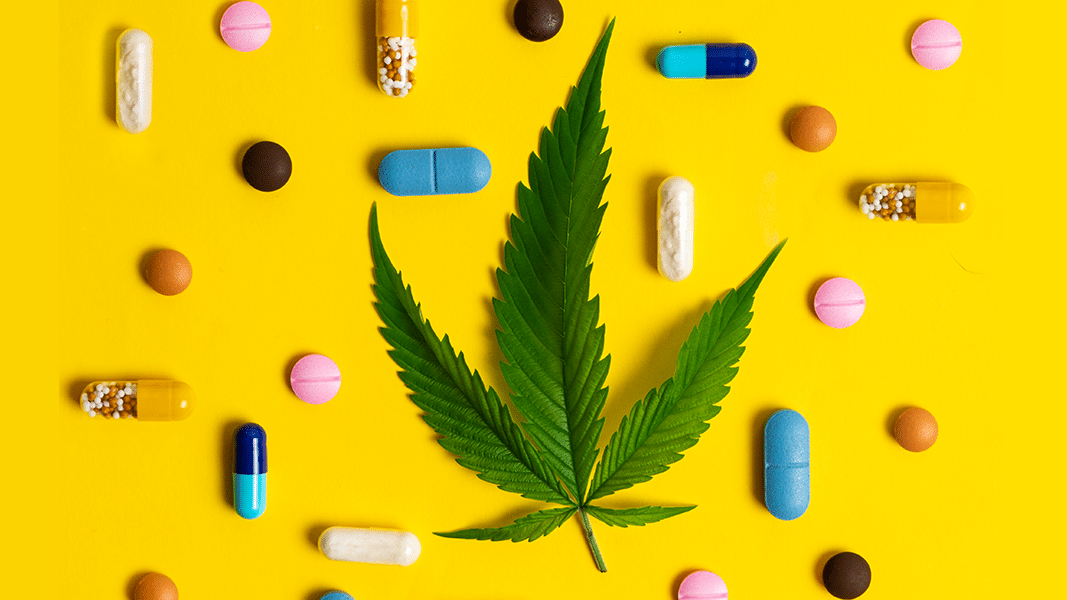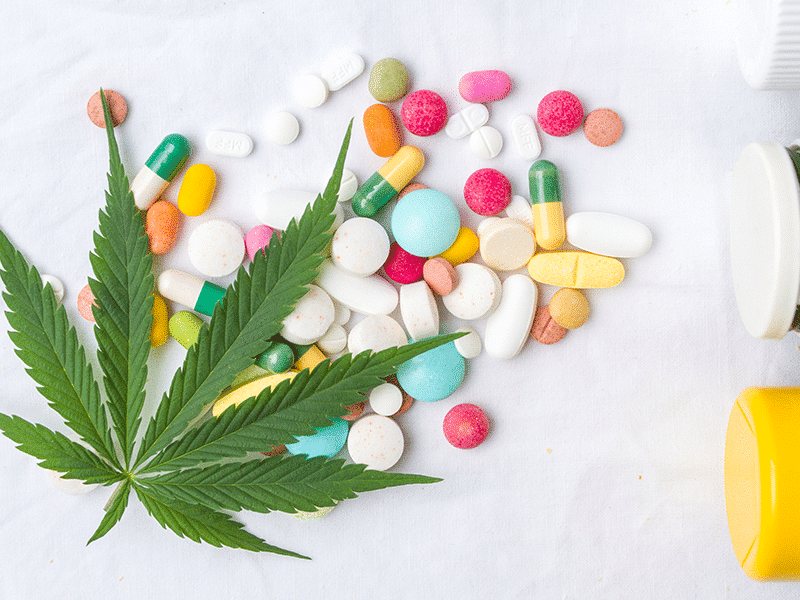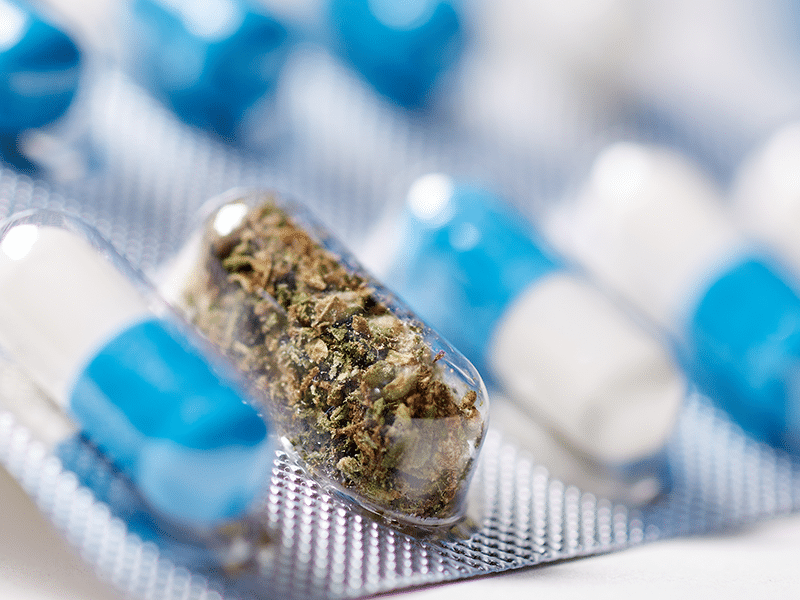Polypharmacy – the use of five or more medications on a daily basis – is a modern-day health crisis. A lack of knowledge about drug interactions increases the likelihood of side effects or adverse reactions, with many patients reporting lower quality of life as a result.
In contrast, patients using medical cannabis are often able to reduce the number of prescription drugs they are taking while better managing their symptoms. Could cannabis be the safer alternative prescribers and patients are looking for?
What Is Polypharmacy?
For the average person living in today’s world, the older we get, the more drugs we are likely to take. In the United States, 35.8% of older adults take five or more prescription medicines. This increases to 67.1% when we throw in over-the-counter medication and supplements.1
Of course, we’re all living longer, and with old age often comes any number of chronic diseases, each with their own prescription pill. Statistically, the more drugs we are prescribed, the higher the risk of adverse drug reactions.2 In the UK, 6.5% of hospital admissions occur thanks to adverse drug reactions (ADR),3 and an estimated 90% of older adults hospitalized due to ADR are taking multiple medications.4
Unfortunately, more drugs doesn’t necessarily mean a patient’s symptoms are well managed or that they have better quality of life. A 2019 study by University of Pittsburgh researchers investigated the use of polypharmacy in palliative care and found that patients actually experienced lower quality of life and higher symptom burden.5 The authors suggest this could be attributed to medication-associated symptoms rather than the diseases themselves; something known as the “prescribing cascade.”
Sir Munir Pirmohamed, a British professor of molecular and clinical pharmacology, has even gone as far as to suggest that pharmaceutical drugs are “poisoning” the elderly.6
As he explained to a House of Lords committee hearing on healthier living in old age, “[T]hose drugs are used at conventional doses and those doses have been tested in younger populations who had exclusion criteria for trials – so they have been tested in people who don’t have the multiple diseases,” he said. “So, when we use a drug at a dose which is licensed at the moment, we are often ‘poisoning’ the elderly because of the dosing that we are using.”
Health professionals often struggle to stay abreast of all the medications their patients are taking, particularly when they are not the only prescriber involved in their care.
This was the experience of Eloise Thiesen, a nurse practitioner and current president of the American Cannabis Nurses Association. A chronic pain patient herself, Eloise ended up in the emergency room after the addition of yet another prescription drug caused a potentially fatal adverse effect.
“I was being prescribed multiple medications,” Thiesen told Project CBD. “When they added in the eighth medication and they weren’t communicating with each other, I ended up with serotonin syndrome, which can put you in a coma and kill you. So, they don’t communicate. It may be in your chart, but how do they make sure that information is following you from specialist to specialist. It’s a huge gap in our healthcare system.”
Cannabis – Nature’s Antidote to Polypharmacy
Thiesen’s firsthand experience of how cannabis could effectively manage her pain, allowing her to come off the prescription drugs she was taking, inspired her open the Radicle Health Clinic specializing in medical cannabis.
“On average in my clinic, the elderly patients I see are taking around seven medications to manage their symptoms. So I see a lot of side effects related to the polypharmacy,” says Thiesen.
“For a typical pain patient that comes to me, the standard of care is to use Tylenol or maybe short term anti-inflammatories. If that doesn’t work, they’re put on Tramadol, and then of course if that doesn’t work, they’re put on other opioids. Then they may be put on something like gabapentin to help with their nerve pain. Now they’re on an antidepressant because their pain’s not well managed, and they’re anxious because they’re not really sleeping because their pain is unmanaged.”
A number of studies have shown how in US States where medical cannabis is legal, opioid prescriptions are significantly reduced.7 But cutting down on opioids is only part of the story.
Thiesen: “I’m really passionate about helping people get off medication to see what life would be like with cannabis and without the pharmaceuticals because I think their quality of life is going to improve dramatically.
“Over and over I hear people say to me, ‘I’m getting my life back.’ Their thinking is clearer, they’re engaged again with their loved ones. They really are in the present moment, and it’s miraculous to see.”
Polypharmacy in Children
However, the dangers of polypharmacy don’t only affect the elderly. Patients with intractable illnesses such as epilepsy, many of whom are children, are often prescribed a cocktail of drugs that fails to manage their symptoms and comes with a host of side effects.
Ten-year-old Ava Barry, who suffers from Dravet Syndrome, a rare type of epilepsy, was prescribed a series of pharmaceutical drugs as doctors struggled to manage her violent seizures.
Her mother, Irish medical cannabis activist Vera Twomey, recalls: “As the situation progressed, the medications weren’t working so she was put on one after another after another. And although she was being put on subsequent medications because the initial ones weren’t controlling the seizures, they weren’t removed. They were just put in tandem with a new one to try.”
“I actually wondered why are we still on them if they’re not working,” remembers Vera. “And you would never get anything apart from, ‘Well you know, we’re trying combinations and we’re using things together.’
“The thing is,” says Vera, “you have to consider the side effects and they were brutal. One of the medications caused Ava to drool. If it were controlling the seizures and you had to compare the consequences of drooling or seizures, you’re going to pick drooling. But the thing was it wasn’t controlling the seizures, it wasn’t working. Our situation went on like that for a long time until she was on 15 tablets a day.”
And yet, Ava continued to have seizures – until her parents took a leap of faith and tried cannabis. Ava started out on an over-the-counter hemp derived CBD oil, and her seizures immediately began to reduce. The family then relocated to the Netherlands where, under the care of a pediatric neurologist, Ava’s seizures further decreased with a combination of CBD and THC.
Twomey: “So you have the situation when you’re introduced to medical cannabis, the seizures stop, and you realise that it may not be extremely dangerous to consider removing one of the pharmaceutical medications. Then you remove the first pharmaceutical medication, which we did very responsibly, and nothing bad happened. And then the next one went and then the final one went.
“After a certain amount of time after returning from Holland, Ava wasn’t on any pharmaceutical medication anymore. And she still isn’t. She’s on CBD and THC twice a day. That’s it.”
Children with severe autism spectrum disorder (ASD) are also frequently given multiple medications by doctors trying to treat their complex cluster of symptoms. Among physicians, prescribing a combination of antipsychotics, antiseizure drugs, benzodiazepines, and antidepressants is not uncommon.
An Israeli prospective study outlining the efficacy and tolerability of CBD-rich cannabis oil in children with ASD found that as well as significantly improving behaviour cannabis treatment had the added benefit of reducing the consumption of concomitant medications in 34.3% of patients.8
Why Cannabis?
For prescribers used to the single molecule model predominant in the development of pharmaceutical drugs, using a botanical extract containing hundreds of active compounds goes against the grain. After all, how do you know which molecule is doing what? But the complex and variable nature of cannabis could be exactly what makes it a potential solution for combatting the polypharmacy crisis.
Where else will you find a relatively side-effect-free medication that is analgesic, anti-inflammatory, antiemetic, anxiolytic, antidepressant, and an aid to sleep? An herbal remedy that is both nonaddictive and free from the risk of drug-drug interactions, as all the therapeutic effects are contained within one synergistic, botanical substance.
When put in those terms, it should be a no-brainer for prescribing physicians. And yet thanks to the ongoing stigma and anachronistic policies stymying medical cannabis research, doctors feel more comfortable prescribing a cocktail of pharmaceutical drugs with unknown or potentially dangerous consequences for their patient’s health.
“Clinicians, particularly physicians, want clinical trials, the human research,” says Eloise Thiesen. “I think there’s enough observational data out there to start getting them to be curious, but I don’t think they’re going to adopt cannabis as a treatment modality until they have more clinical trials to demonstrate how much to use, how often to use, and which cannabinoids are most effective.”
“Right now,” Thiesen adds, “I think patients are leading the change. So I think we’re in another revolution.”
Mary Biles, a UK-based journalist, educator, and Project CBD contributing writer, is the author of The CBD Book (Harper Collins, UK). © Copyright, Project CBD. May not be reprinted without permission.
References
- Dima M. Qato, Jocelyn Wilder, L. Philip Schumm, Victoria Gillet, and G. Caleb Alexander. Changes in Prescription and Over-the-Counter Medication and Dietary Supplement Use Among Older Adults in the United States, 2005 vs 2011. JAMA Intern Med. 2016 Apr; 176(4): 473–482
- Johnell K, Klarin I. The relationship between number of drugs and potential drug-drug interactions in the elderly: a study of over 600,000 elderly patients from the Swedish Prescribed Drug Register. Drug Saf. 2007;30(10):911-8.
- Munir Pirmohamed Sally James, Shaun Meakin, Chris Green, Andrew K Scott, Thomas J Walley, Keith Farrar, B Kevin Park, Alasdair M Breckenridge. Adverse drug reactions as cause of admission to hospital: prospective analysis of 18 820 patients. BMJ 2004;329:15
- Pedrós C, Formiga F, Corbella X, Arnau JM. Adverse drug reactions leading to urgent hospital admission in an elderly population: prevalence and main features. Eur J Clin Pharmacol. 2016 Feb;72(2):219-26
- Yael Schenker, Seo Young Park, Kwonho Jeong, Jennifer Pruskowski, Dio Kavalieratos, Judith Resick, Amy Abernethy, Jean S. Kutner. Associations Between Polypharmacy, Symptom Burden, and Quality of Life in Patients with Advanced, Life-Limiting Illness. J GEN INTERN MED (2019) 34: 559.
- Nicola Davis. Elderly people being ‘poisoned’ by medication, say drug experts. The Guardian 29 October 2019
- Ashley C. Bradford, W. David Bradford, Amanda Abraham. Association Between US State Medical Cannabis Laws and Opioid Prescribing in the Medicare Part D Population. JAMA Intern Med. 2018;178(5):667-672.
- Bar-Lev Schleider, L., Mechoulam, R., Saban, N. et al. Real life Experience of Medical Cannabis Treatment in Autism: Analysis of Safety and Efficacy. Sci Rep 9, 200 (2019)
Recommended Readings
Project CBD Releases Primer on Cannabinoid-Drug Interactions
Physicians and patients need to understand how cannabis interacts with common pharmaceuticals.
CBD Drug Interactions: What You Need to Know
Drug interactions can be useful and dangerous. Learn how CBD and THC may effect pain meds, statins, blood thinners, insulin and more.
New Cannabinoid-Drug Interactions
Large doses of THC, CBD, and CBN could make processing blood pressure drugs and Ritalin more difficult.












